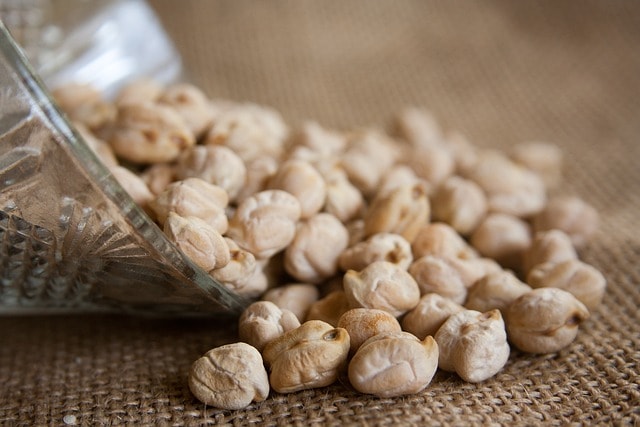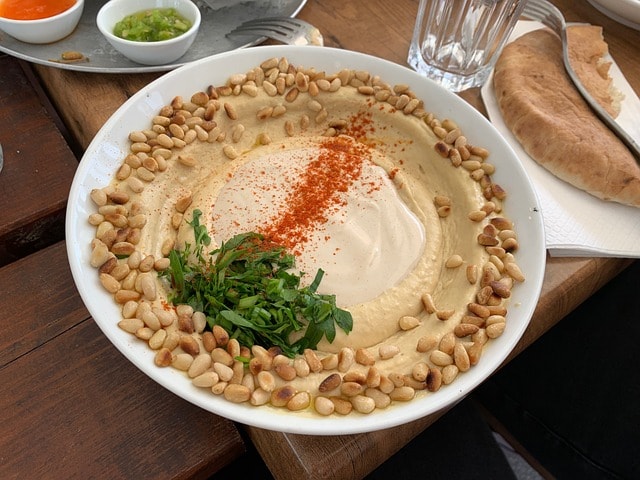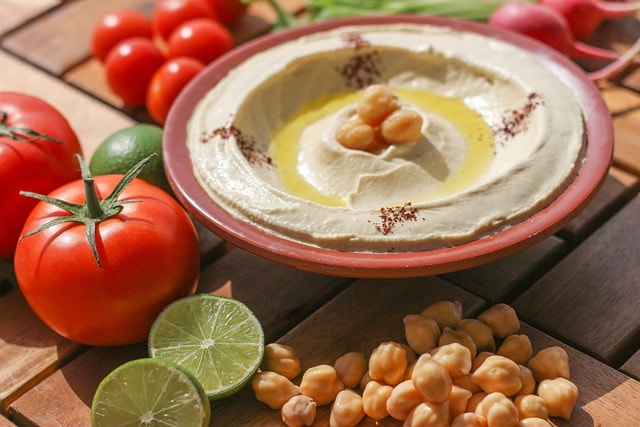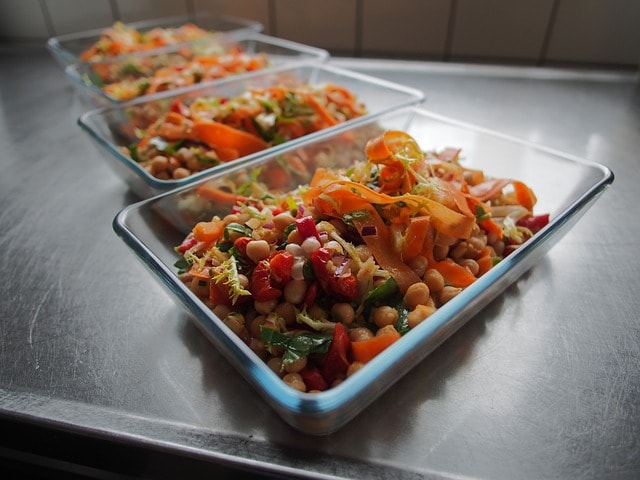Garbanzo beans, also known as chickpeas (Cicer arietinum), have been a staple in global cuisine for thousands of years. These small, round legumes are power-packed with nutrition, have a unique nutty flavor, and are versatile in various dishes.
Whether enjoying a hearty bowl of hummus or adding them to a fresh salad, garbanzo beans bring texture and nutrition. Thanks to growing interest in plant-based diets and the quest for healthier, protein-packed foods, they have been popular in recent years.
But what exactly makes them so unique? Beyond their delicious taste, they are high in nutrition, offering a rich protein, fiber, vitamins, and minerals source. Their adaptability in cooking, combined with their health benefits, has made them a favorite among chefs and health enthusiasts.
Chickpeas vs. Garbanzo Beans: Are They Different?
No, garbanzo beans and chickpeas are not different. They are two names for the same beans. These are also known as ceci beans or Egyptian peas. The only difference is the terms used for these beans. The term ‘chickpea’ is derived from the Latin word cicer and is a more preferred term in English-speaking countries.
The Spanish-speaking countries and some areas of the United States often use the term ‘Garbanzo’ for the same legume. Both terms can be used interchangeably for this versatile and nutritious food.

Types of Chickpeas
Chickpeas are round and beige-colored with a firm texture. These come in various types that differ in size, color, and texture.
The two main varieties of chickpeas are Desi and Kabuli chickpeas. Both are unique in taste and culinary uses.
1. Desi Chickpeas
Desi chickpeas are also known as Kala chana and Bengal gram. This type of garbanzo bean is smaller and has a thick and rough coat. These are darker in shade, often brown or black. This type is primarily grown in the Indian subcontinent, Ethiopia, and Mexico.
A rich source of plant proteins and essential minerals, including iron, magnesium, potassium, folate, and vitamin B6. Desi chickpeas are higher in fiber and antioxidants compared to other types. Moreover, these beans have a lower glycemic index, suitable for blood sugar management.
Culinary Uses: Used in many traditional dishes. The chickpea flour, called besan, is used in various recipes.
2. Kabuli Chickpeas
Kabuli chickpeas, kabuli chana, or chana dal, are beige-colored beans that look like wrinkled hazelnuts. These are larger and lighter in the shade compared to other varieties. This variety is commonly grown in the Mediterranean, Southern Europe, North Africa, and some areas of the United States.
Kabuli chickpeas are rich sources of proteins, vitamins, and essential nutrients but have slightly lower fiber content than other varieties.
Culinary Uses: Kabuli chickpeas are popular in Mediterranean, West Coast, Middle Eastern cuisines, such as hummus and fermented products offering a healthy alternative to eggs and peanuts for those looking for plant-based protein options.
With varieties like chibbar rn and gaur pm, garbanzo beans offer versatility and flavor while supporting a balanced diet.

Health Benefits of Chickpeas
This excellent legume has a rich protein profile. These are packed with plant fiber, vitamins, and minerals, making them healthier additions to the diet.
Here are some key health benefits:
1. Supports Digestive Health
Chickpeas are an excellent source of dietary fiber. The soluble fibers blend with water, forming an insoluble, gel-like substance in your digestive tract that promotes regular bowel movements and prevents constipation.
Study suggests that soluble fiber may help with the gut microbiota, supporting healthy gut bacteria and suppressing unhealthy bacteria’s overgrowth. Research suggests that chickpeas can also helps in terms of reduced risk of some digestive conditions, such as irritable bowel syndrome (IBS) and colon cancer.
2. Helps In Weight Loss
Since these beans are rich in plant proteins and fibers, they create a feeling of fullness. According to a study, this reduces overall calorie intake and helps in weight management.
3. Helps Regulate Blood Sugar Levels
Chickpeas have a low glycemic index (GI), a marker of how rapidly your blood sugar rises after eating a food. Thus, their low glycemic index helps maintain steady blood sugar levels. Studies reveal that chickpeas suppressed post-meal increases in blood sugar levels by up to 36% compared with two slices of white bread.
According to recent studies, the rich fiber and protein profile is associated with reduced risk of several diseases, including diabetes and heart disease, due to their low glycemic index.
As a rich source of minerals, including potassium and magnesium, these support heart health. These minerals help prevent high blood pressure — a significant risk factor for cardiovascular disease.
In addition, the soluble fibers help reduce cholesterol absorption in the bloodstream. According to research, chickpeas also lower the absorption of triglycerides and LDL (bad) cholesterol levels, the main risk factors for cardiovascular diseases.
5. Improves Bone Health
Garbanzo beans are a rich source of minerals, including Calcium, Magnesium, and Phosphorus. Thus, they are helpful in maintaining bone density, promoting bone health, and reducing the risk of osteoporosis.
Prevent Iron Deficiency
Garbanzo beans are an excellent source of iron. One cup of these beans contains approximately 26% of the DV. Iron is crucial to supporting critical body functions such as red blood cell production, brain development, physical growth, and other aspects of health. Moreover, these make an ideal choice for vegans and vegetarians who are at high risk of iron deficiency.
In addition, this may also help with better immune system functioning and brain health and boost energy levels.
Nutritional Profile and Comparison
Nutritional Value per 100 g (source)
| Nutrient | Unit | ||
| Chickpeas, Dry (16056) cValue per 100 g a | |||
| Macronutrients | |||
| Energy | Kcal | 378 | |
| Protein | g | 20.47 | |
| Fat | g | 6.04 | |
| Carbohydrate | g | 62.95 | |
| Fiber | g | 12.2 | |
| Sugar | g | 10.7 | |
| Minerals | |||
| Calcium | mg | 57 | |
| Iron | mg | 4.31 | |
| Magnesium | mg | 79 | |
| Phosphorus | mg | 252 | |
| Potassium | mg | 718 | |
| Sodium | mg | 24 | |
| Zinc | mg | 2.76 | |
| Copper | mg | 0.656 | |
| Manganese | mg | 21.306 | |
| Selenium | μg | 0 | |
| Vitamins | |||
| Vitamin C | mg | 4.0 | |
| Thiamin | mg | 0.477 | |
| Riboflavin | mg | 0.212 | |
| Niacin | mg | 1.541 | |
| Pantothenic acid | mg | 1.588 | |
| Vitamin B6 | mg | 0.535 | |
| Folate | μg | 557 | |
| Choline | mg | 99.3 | |
| Vitamin B12 | μg | 0 | |
| Vitamin A | IU | 67 | |
| Vitamin D | μg | 0 | |
| Vitamin K | μg | 9.0 | |
| Vitamin E | mg | 0.82 | |
| Lipids | |||
| Saturated | g | 0.603 | |
| Monounsaturated | g | 1.377 | |
| Polyunsaturated | g | 2.731 |
Storage Tips for Garbanzo Beans (Chickpeas)
Proper storage of chickpeas is the key to preserving their freshness and flavor.
Whether you have dried, canned, or cooked chickpeas, following these storage tips will help extend their shelf life.
1. Storing Dried Chickpeas
Dried chickpeas can be stored for 1-2 years if stored properly. However, they will need additional cooking time if stored for too long. You can store as follows:
Use an airtight container. Store dried chickpeas in an airtight container to protect them from moisture and mold. Keep the container in a cool, dark place like a pantry or cupboard, away from direct sunlight and heat, to prevent them from becoming rancid.
2. Storing Canned Chickpeas
Canned chickpeas are generally suitable for 1- 2 years or even more if stored properly. Here is how you should store canned beans:
The Unopened Cans: Store canned chickpeas in a cool, dry place. They typically last for more than 2 years.
Opened Cans: Once the can is open, its shelf life only reduces to 3-4 days. You should transfer any leftover chickpeas from an opened can into an airtight container and refrigerate them for Use in the next 3 -4 days.
3. Storing Cooked Chickpeas
Use an airtight container. Put them in the refrigerator, and they will stay fresh for 3-5 days.
If you want to store it longer, try the freezing method. Spread them well on a baking sheet to absorb moisture, then transfer them to a freezer-safe bag or container. They can be stored in the freezer for up to 6 months.
General Tips
- Avoid Moisture: Moisture can cause chickpeas to spoil quickly, allowing mold fungus to grow. Make sure containers are completely dry and airtight.
- Labeling: Label containers with the date of storage to keep track of freshness. This is particularly important for cooked and canned chickpeas.
- Inspect Before Use: When using the stored chickpeas, check for signs of mold, off smell, or discoloration. Always rinse to remove any salt and preservatives.
Culinary Uses for Chickpeas and Garbanzo beans
Chickpeas are incredibly versatile and can be used in various cuisines. Their mild, nutty flavor and firm texture suit many recipes. Here are some popular culinary uses for chickpeas:
1. Hummus
A classic Middle Eastern dip made by blending roasted chickpeas with tahini, olive oil, lemon juice, and garlic. It is served with fresh pita bread and vegetables and is sometimes used as a speed for wraps and sandwiches.
2. Falafel
A popular Mediterranean street food made from chickpeas flour mixed with herbs and condiments, formed into balls or patties and deep-fried. This is served with pita bread and rice, with sides of pickles and sauces.

3. Salads
Chickpeas make an excellent addition to salads as they are rich in plant proteins, minerals, and fiber.
4. Curries and Stews
Chickpeas are often used in curries, soups, and stews, especially in India, the Middle East, and North Africa.
5. Roasted Chickpeas
When blended with spices, roasted chickpeas create a crunchy, flavorful snack. It can be used as a healthy alternative to chips and snacks.

6. Chickpea Flour (Besan)
This is made from ground chickpeas and is used in various dishes. This makes flatbreads, fritters, socca (a French pancake), or pakoras (Indian fritters). Moreover, it is used as a gluten-free alternative in baking.
7. Vegetarian and Vegan Dishes
Chickpeas are a key ingredient in many vegetarian and vegan dishes as an alternative to meat. Due to their high protein content, these are often used as a base for vegan “tuna” salad.
8. Desserts
Chickpeas have a neutral flavor that suits them for sweet dishes. They can be used in cookies or as a base for vegan ice creams and puddings.
Are Chickpeas a Healthy Choice for You?
Chickpeas, or garbanzo beans, are highly nutritious and can be a healthy addition to most diets. They are rich in plant-based protein, making them an excellent option for vegetarians and vegans. This high-fiber food supports digestive health by promoting regular bowel movements and feeding beneficial gut bacteria.
Chickpeas have a low glycemic index, which helps maintain steady blood sugar levels, making them suitable for people with diabetes. These nutrients play crucial roles in various bodily functions. Regular consumption of chickpeas can also manage chronic diseases and support heart health by helping to lower cholesterol and blood pressure levels.
However, individuals with digestive sensitivities to pulses or legumes should consume chickpeas in moderation and consider soaking and cooking them thoroughly to reduce potential discomfort.
Conclusion
Chickpeas (Cicer arietinum) are rich in protein, fiber, and micronutrients. Eating beans is beneficial as they can support heart health, manage weight, enhance bone health, and provide sustained energy. Incorporating chickpeas into your diet in various forms—whether in salads, soups, or dips – can contribute to overall health and well-being. However, those with digestive sensitivities or allergies should consume them with caution.
















